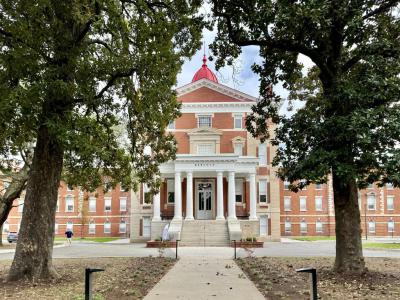Babcock Building, South Carolina Lunatic Asylum, Columbia
The Babcock Building is a significant historical structure that highlights the evolution of mental health treatment in the United States. In 1821, South Carolina became the second state to allocate funds for the treatment of mental illness and the education of the deaf and dumb, approving the construction of the South Carolina Lunatic Asylum. Designed by architect Robert Mills, construction of the Mills Building began in 1822, and the asylum admitted its first patient in 1828. However, the need for additional space due to a growing population led to the construction of the Babcock Building almost thirty years later.
The Babcock Building's initial design was created by George E. Walker, but only the south wing was completed at first. Subsequent architectural contributions included Gustavus T. Berg for the north wing and Samuel Sloan for the central building, which connected both wings. The construction process faced numerous delays, resulting in a protracted four-phase development that spanned nearly three decades. By 1885, the Babcock Building finally began accepting patients, marking a significant expansion in the asylum’s capacity.
Architecturally, the Babcock Building is notable for its Italian Renaissance Revival style, featuring a four-story central structure with a prominent cupola, flanked by north and south wings designated for male and female patients, respectively. The building was adorned with wood floors and trim, enhancing its aesthetic appeal. The central structure housed operating rooms on the second floor, residential spaces for the Supervisor and some doctors on the third and fourth floors, and dining halls for patients. Originally, each ward floor contained individual patient rooms, although renovations beginning in 1915 altered some of these layouts.
The historical importance of the Babcock Building was recognized in 1981 when it was placed on the National Register of Historic Places. Despite its later abandonment in the 1990s, the Babcock Building remains a significant landmark, reflecting both the architectural heritage and the evolving approaches to mental health care in the United States.
The Babcock Building's initial design was created by George E. Walker, but only the south wing was completed at first. Subsequent architectural contributions included Gustavus T. Berg for the north wing and Samuel Sloan for the central building, which connected both wings. The construction process faced numerous delays, resulting in a protracted four-phase development that spanned nearly three decades. By 1885, the Babcock Building finally began accepting patients, marking a significant expansion in the asylum’s capacity.
Architecturally, the Babcock Building is notable for its Italian Renaissance Revival style, featuring a four-story central structure with a prominent cupola, flanked by north and south wings designated for male and female patients, respectively. The building was adorned with wood floors and trim, enhancing its aesthetic appeal. The central structure housed operating rooms on the second floor, residential spaces for the Supervisor and some doctors on the third and fourth floors, and dining halls for patients. Originally, each ward floor contained individual patient rooms, although renovations beginning in 1915 altered some of these layouts.
The historical importance of the Babcock Building was recognized in 1981 when it was placed on the National Register of Historic Places. Despite its later abandonment in the 1990s, the Babcock Building remains a significant landmark, reflecting both the architectural heritage and the evolving approaches to mental health care in the United States.
Want to visit this sight? Check out these Self-Guided Walking Tours in Columbia. Alternatively, you can download the mobile app "GPSmyCity: Walks in 1K+ Cities" from Apple App Store or Google Play Store. The app turns your mobile device to a personal tour guide and it works offline, so no data plan is needed when traveling abroad.
Babcock Building, South Carolina Lunatic Asylum on Map
Sight Name: Babcock Building, South Carolina Lunatic Asylum
Sight Location: Columbia, USA (See walking tours in Columbia)
Sight Type: Attraction/Landmark
Guide(s) Containing This Sight:
Sight Location: Columbia, USA (See walking tours in Columbia)
Sight Type: Attraction/Landmark
Guide(s) Containing This Sight:
Walking Tours in Columbia, South Carolina
Create Your Own Walk in Columbia
Creating your own self-guided walk in Columbia is easy and fun. Choose the city attractions that you want to see and a walk route map will be created just for you. You can even set your hotel as the start point of the walk.
Historical Houses and Buildings Walk
Columbia is a city rich in history and architectural heritage, boasting an array of old-time buildings that offer a window into its storied past. From grand antebellum mansions and elegant townhouses to significant public edifices and modest residences, each of these structures tells a unique story, reflecting the diverse cultural, social, and economic tapestry of the city.
Among such, the... view more
Tour Duration: 2 Hour(s)
Travel Distance: 2.7 Km or 1.7 Miles
Among such, the... view more
Tour Duration: 2 Hour(s)
Travel Distance: 2.7 Km or 1.7 Miles
Columbia Introduction Walking Tour
Columbia, the capital and largest city of South Carolina is a treasure trove of historical significance, cultural wealth, and Southern charm. The city's history is marked by its role in the American Civil War. This historical backdrop sets the stage for Columbia’s many landmarks and educational institutions that speak volumes of its resilience and cultural evolution.
In May 1540, a... view more
Tour Duration: 2 Hour(s)
Travel Distance: 3.6 Km or 2.2 Miles
In May 1540, a... view more
Tour Duration: 2 Hour(s)
Travel Distance: 3.6 Km or 2.2 Miles





